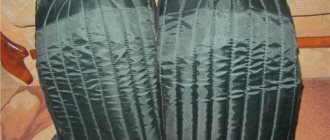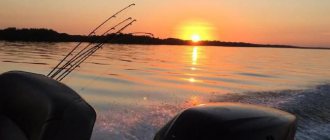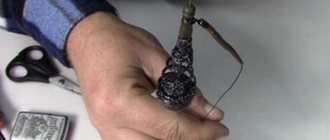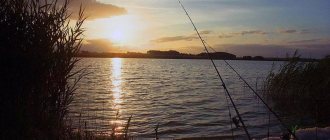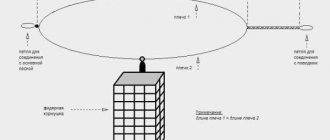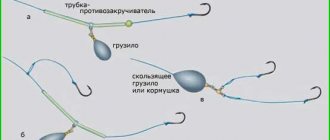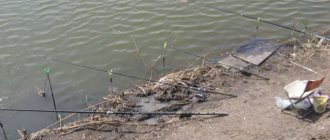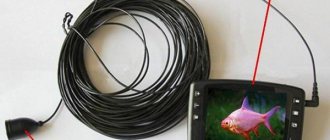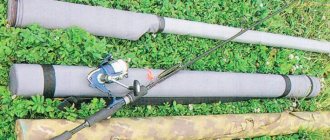A brief overview of catchy bait
Beginner fishermen and more advanced fishermen look for stripers with a variety of gear and methods. But the arrival of the winter season forces them to change their summer preferences, looking for something more unique and functional. In most cases, no-attachment jigs are used for winter fishing, which demonstrate good catchability under any conditions.
The devilless reel is a real masterpiece in the fishing field, which has practically no competitors in terms of efficiency in catching perch . Every fishing fan has such a jig at his disposal, because he knows how useful it is for the winter season.
You can catch not only perch with the devil, but also many other inhabitants of the depths, including:
- Roach.
- Bream.
- Pike perch.
- Bersha.
However, the minke whale reacts to such an invention much more intensely than other types of fish, which is why the bait is often called “perch”.
Externally, it is an elongated drop-shaped jig, about two centimeters long, which is fixed to the fishing line using a small ring located in the upper part of the bait.
At the other end there is not a classic hook, but a tee with multi-colored beads. itself can be painted in different shades , so it can be used for different fishing conditions.
For fishing with a reelless bait, you should take a classic jig tackle, which is pre-equipped with a medium-hard nod. As for fishing line, it is customary to give preference to high-quality and reliable products with a cross-section from 0.1 to 0.15 millimeters.
Such baitless baits can have different weights, sizes and shapes, so experienced fishermen always have several baits in their arsenal for any occasion.
Unlike beginners, who prefer to buy everything at the store, seasoned professionals almost always make their own devil jigs. In fact, it is not difficult to complete such a task, if only you have the desire. And if you also find special molds , then you can pour several dozen of these products without spending a lot of effort, energy, and most importantly, money.
Homemade devils
Globally, all methods of making devils for winter fishing with your own hands can be divided into two large groups:
The simplest options can be done literally “on your knees” using a minimum number of tools and technical skills. Other methods are more difficult, you need to get better at them, but the baits made are in no way inferior, and often even superior in catchability to products from fishing stores.
Features of fishing with a reelless reel
The "catchable" status is only suitable for those baits that are manufactured to meet key requirements and are also correctly provided to the fish. Simply throwing the product into the water is not enough, because it will remain an unremarkable piece of metal with a treble hook. But if you “rein in” this piece of metal by using the right wiring, then it will turn into an ideal tool for searching for trophy prey. Only a responsible approach will justify the effort and make winter fishing effective.
As for the “devil” game, it is somewhat reminiscent of the movements of a classic spinner. The main differences are only that the movements of the first are directed either downwards or upwards , and this very much attracts the striped predator. In addition, the jig is tossed in advance with a fishing rod, after which it flies to the bottom. If there are no bites, the technique is repeated.
When the bait rises, it is given a certain animation by nodding. If you do not do this, the striped predator or other inhabitant of the deep will quickly understand that the proposed prey is a trap, and the chances of a positive reaction will decrease. As soon as you feel the slightest bite that can only register a nod, you must immediately hook, otherwise the fish simply will not catch the hook.
When moving the jig , it is necessary to constantly change the nature of its movement , using fast or slow jerks, lengthening or shortening the pauses between them.
If there is zero activity, try to fish all layers of water, because in winter the fish can stay at any horizon. If these actions do not produce any results, then it is much wiser to change the hole rather than waste precious time. It is important to remember that fishing in winter is a difficult and demanding activity for which you need to properly prepare.
Making a jig with your own hands
Every self-respecting angler has several varieties of devil jigs in his arsenal. Some people use purchased products, while others try to create them themselves.
And the latter option has many significant advantages, including:
- Affordable price.
- Different shape, weight and play.
- Practicality.
- Catchability.
Not all store-bought models are capable of arousing the interest of a striped predator or other fish, so in some cases there is no other choice but to make bait from improvised materials.
Currently, several methods are used to make bait at home. It is created on the basis of various raw materials, but if we talk about homemade products, then, as a rule, these are tin, solder or lead products that can easily melt under the influence of low temperatures.
To make bait you must follow one of the many existing techniques. One of the fishermen prepares a special form into which the material is poured, creating several jigs at once. Others take solder, soldering all the parts together to get the desired shape.
There is another group of people who simply fasten two forends of hooks together, winding wire on top. This creates a very unusual devil shape. The main thing is not to be afraid to show your imagination, as this will allow you to create a bait of almost any shape.
Available tools and materials
To successfully make a mothless machine, you need to find the following materials and tools:
- Small amounts of tin or lead.
- Several hooks.
- Beads.
- Copper wire.
- Wooden block.
- Cold welding.
- Needle files.
- Soldering iron.
- Foil.
To manufacture the product, it is important to follow certain step-by-step instructions, observing increased caution and safety precautions:
- The first thing you need to do is find high-quality hooks with a long shank, from which it is much more convenient to make treble hooks. For this purpose, models number 3 are suitable, in which the ears are bitten off and the areas for soldering are cleaned.
- It is necessary to make three cuts on the wooden workpiece, up to three millimeters deep, which are placed at an angle of 120 degrees.
- Hooks are inserted into such slits so that they point upward with the shank.
- Then you need to take a thin wire and tightly tie the structure with it at the soldering site.
- A so-called funnel is created on the basis of the foil and placed on hooks so that the cone is placed on top of the forend.
- Tin or lead is poured into the middle of the funnel. The main thing is to fill it completely, being careful.
- After the metal has cooled, the finished jig should be taken out and processed to give it the desired size and shape.
- To improve the attractiveness of the product, it is painted in bright colors.
Winter fishing tactics
In most cases, anglers go on winter fishing to hunt for perch, which bite particularly intensely and often. You can catch this striped predator in different ways, but the jig shows the best performance . At the same time, the fish are attracted not by the product itself, its color, shape or size, but by the correctly executed specific game. It should be sharp and jerky, with slight deviations from the vertical axis.
If the movements are smooth, then the bite may simply not be noticed. The mothless fish must move from top to bottom or move on the bottom, creating a high-quality imitation of the movements of living prey, causing the formation of a cloud of turbidity, which always arouses the interest of underwater inhabitants.
Fishing in winter is always problematic, especially if the weather conditions are very harsh and there is severe frost outside. Such bad weather also has a bad effect on the behavior of the perch, so it often hides in the depths, looking for shelter. Very often he spends a lot of time there, not showing himself to the fisherman until the temperature rises.
If the ice is very strong, and oxygen starvation begins in the reservoir, then the fish will en masse go into underwater depressions , edges or dumps in them. If there is enough air, the minke whale will often bask in shallow areas where trees and snags are present.
It is believed that perch bites well in calm, windless weather, when there is slight frost outside. Moreover, its activity can constantly change and depend on many factors. Of course, it is advisable to start fishing in the early morning, although a good bite is possible both during the day and in the evening.
Catching other types of fish
It is important to note that, in addition to perch, other inhabitants of the depths also respond well to the mothless fish, especially if there are many of them in the reservoir. For example, you can take the following types of fish:
- Roach.
- Crucian carp.
- Ruff.
- Guster.
- Pike.
- Podleschik.
- Bream.
- Rudd.
- And many other representatives of underwater fauna, not only predators, but also peaceful species. By the way, large specimens fall for such bait much more often than for all others.
The devil jig is truly one of the most amazing fishing tools that can make winter ice fishing not just exciting, but also productive. This is explained by the fact that the beautiful and unusual game of the mothless fish arouses extraordinary interest among all underwater inhabitants. And if we talk about perch, then it simply cannot ignore such prey, even if the weather is bad and there is severe frost outside.
Arrival of the spring season
With the arrival of spring, the situation on the reservoir begins to change significantly. As soon as the air temperature begins to rise, and the inhabitants of the depths feel the arrival of warmth, they will begin a real revolution and a desire to quickly leave their winter shelters to meet the new season. And the last ice is a very problematic period for fishing using the reelless method. Every day the preferences of underwater inhabitants change, and they begin to abandon their previous habitats, habits and food preferences.
However, it is in the spring that perch, and other representatives of the underwater fauna, are caught incredibly well with a devil jig. But it is important to take the right approach to the choice of colors, sizes and wiring techniques, giving preference to brighter and more noticeable shades , as well as a more attractive game. Some experienced fishermen claim that a jig with an “earring” pendant, which is used as part of a so-called steam locomotive, performs especially well, where a shiny jig equipped with red and greenish beads is used as the top bait.
Such products complement each other perfectly, increasing the intensity of bites by about half. With normal wiring, the “earring” plays very attractively, and most reactions to the bait occurred when it was raised up.
When fishing on the last ice, devils have practically no competitors. The only ones that can compete with them are the “watermelon” and “Rybinsk” baits . But this is not certain, because a lot depends on the weather conditions in the region, the individual characteristics of the reservoir, as well as the habits and preferences of the prey itself.
In order not to go home empty-handed and in a bad mood, it is important to correctly approach all the important subtleties of fishing, changing wiring, colors and other possible configurations. And the more experiments are carried out, the higher the chances of a good catch. The main thing is not to give up and continue to work, learning all the delights of such a unique activity as catching perch with a devil jig.
How to catch devils in winter: techniques and tips
The holes are drilled in the standard way. Promising places are selected and holes are drilled in a checkerboard pattern every 8-12 meters. First drill up to 15-20 holes. Fishing begins from the first hole, which has already rested.
If the fishing point is chosen correctly, then there are three components of success - the correctly chosen devil, the correctly configured tackle and the presentation (read wiring) of the reelless reel. This section is about wiring and secrets. Wiring a reelless jig is more important than a jig edged with yummy food in the form of bloodworms and other live bait. This is understandable - the bloodworm praises itself.
Before going to the reservoir and on the reservoir itself, you should pay attention to the following factors that in one way or another affect the quality of fishing and the final success:
Basic postings
There is not and cannot be a single correct wiring for the devil. In different conditions (body of water, type of fish, depth, atmospheric conditions, etc.) different types of animation will be good. But the prompt selection of that same recipe for specific fishing conditions is the basis of success, the basis of which is the experience of the fisherman.
Also, do not forget that the style of animation of the bait, as well as the bait itself, should fit, as they say, “into the hand”, be consistent with the character of the fisherman, his vision of fishing as a whole.
Practical fact. A fisherman, albeit less experienced, but who has thoroughly studied a particular body of water and the habits of its inhabitants, will always catch a more experienced “devil fisher”, but who has found himself in new conditions for the first time. There is no point in catching perch where there is raft or bream, be it a spoon or a devil.
But it wouldn’t be superfluous to study the basics of animating mothless creatures (why reinvent the wheel in the 21st century), especially for novice imps.
Jig animation options
Standard - classic step
The most common wiring among others. Its advantage is its versatility and working qualities for a variety of fish.
The imp descends to the bottom of the hole, a pause is given until the nod is played to a strictly horizontal position. The overhang of the fishing line is noticeable. Then, with progressive movements, the rewinder rises to the surface in steps. This is clearly noticeable by the nod - the devil seems to move from step to step with smooth movements of the fishing rod.
The step size between steps can vary from 1-2 cm to 10-15 cm. It all depends on how aggressive the wiring is needed. Let's say that slow dribbling is good for perch; the more chaotic, the better. And the roach prefers short steps of 5-7 cm with pauses.
Pauses between throwing the jig from step to step can vary from practically non-existent to quite significant, up to 5-10 seconds or more. The more active the fish, the shorter the pause - in general, this is exactly the animation that works.

